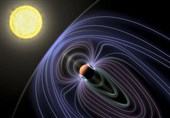'Super Puff' Exoplanet Confusing Astronomers
TEHRAN (Tasnim) – About 212 light years from Earth, a gas giant light enough to be nicknamed a "super-puff" or "cotton candy" planet is circling extremely close to its host star. The exoplanet is so light, it's left astronomers questioning everything we previously knew about how gas giants form.
This super-puff exoplanet, known as WASP-107b, is about the same size as Jupiter, but only about one-tenth the mass — or about 30 times more massive than Earth. According to a new study published Monday in The Astronomical Journal, its core mass is significantly smaller than astronomers thought necessary for the creation of a gas giant planet like Jupiter and Saturn.
The discovery, made by PhD student Caroline Piaulet under the supervision of professor Björn Benneke at the University of Montreal, indicates that gas giants form much more easily than previously believed.
"This study pushes the boundaries of our theoretical understanding of how giant-sized planets form. WASP-107b is one of the puffiest planets out there, and we need a creative solution to explain how these tiny cores can build such massive gas envelopes," coauthor Eve Lee said in a statement.
WASP-107b isn't a brand new discovery — astronomers first detected it in the Virgo constellation in 2017. The planet is very close to its star, over 16 times closer than Earth is to the sun, completing one orbit every 5.7 days.
WASP-107b is one of the least dense exoplanets scientists have ever found. They have nicknamed similar types of planets — gas giants with the density of cotton candy — super-puffs.
To find the planet's surprising mass, astronomers studied observations obtained at the Keck Observatory in Hawaii. They used a technique called the radial velocity method, which studies the wobbling motion of a planet's star caused by a planet's gravitational pull, in order to calculate the mass.
Scientists were shocked to conclude that the solid core of WASP-107b has a mass that is no more than four times that of the Earth, meaning more than 85% of its mass stems from the thick gaseous layer surrounding the core. This is a dramatically different breakdown from Neptune, which has a similar mass but holds just 5% to 15% of it within its gas layer.
Based on their knowledge of Jupiter and Saturn, scientists previously believed that a solid core at least 10 times the mass of Earth would be needed to acquire enough gas for a gas giant planet to form. WASP-107b challenges that theory.
"This work addresses the very foundations of how giant planets can form and grow," Benneke said. "It provides concrete proof that massive accretion of a gas envelope can be triggered for cores that are much less massive than previously thought."
Lee posits that, "The most plausible scenario is that the planet formed far away from the star, where the gas in the disc is cold enough that gas accretion can occur very quickly. The planet was later able to migrate to its current position, either through interactions with the disc or with other planets in the system."
While studying the planet, the team stumbled upon another in the same system, WASP-107c. It has a mass that is about one-third that of Jupiter and takes three years to orbit its host star once.
The planet's oval-shaped orbit suggests that the astronomers' new hypothesis is on the right track.
"WASP-107c has, in some respects, kept the memory of what happened in its system," said Piaulet. "Its great eccentricity hints at a rather chaotic past, with interactions between the planets which could have led to significant displacements, like the one suspected for WASP-107b."
The team hopes to continue studying the strange planet with the launch of the James Webb Space Telescope this year.






